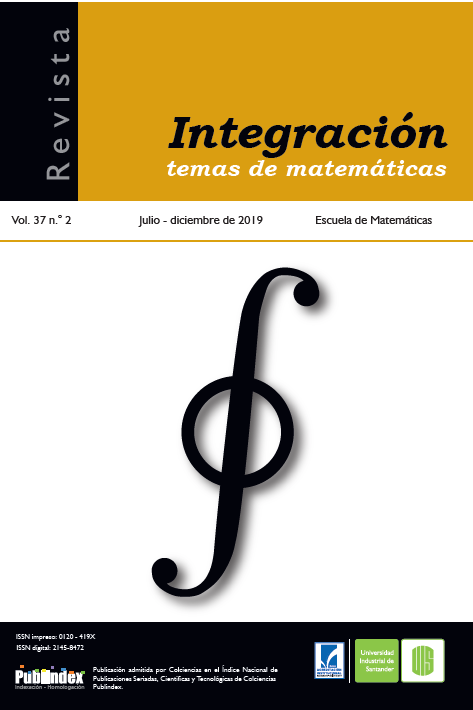Research and Innovation Articles
Published 2019-07-29
Keywords
- Von Neumann stability analysis,
- CFL,
- Local Discontinuous Galerkin (LDG)
How to Cite
Castillo, P., & Gómez, S. (2019). Von Neumann analysis for the Local Discontinuous Galerkin method in 1D. Revista Integración, Temas De matemáticas, 37(2), 199–217. https://doi.org/10.18273/revint.v37n2-2019001
Abstract
Using the von Neumann analysis as a theoretical tool, an analysis
of the stability conditions of some explicit time marching schemes, in combination
with the spatial discretization Local Discontinuous Galerkin (LDG)
and high order approximations, is presented. The stability constant, CFL
(Courant-Friedrichs-Lewy), is studied as a function of the LDG parameters
and the approximation degree. A series of numerical experiments is carried
out to validate the theoretical results.
Downloads
Download data is not yet available.
References
[1] Castillo P., “Stencil reduction algorithms for the Local Discontinuous Galerkin method”, Internat. J. Numer. Methods Engrg. 81 (2010), No. 12, 1475–1491.
[2] Castillo P., Cockburn B., Perugia I. and Schötzau D., “An a priori error analysis of the Local Discontinuous Galerkin method for elliptic problems”, SIAM J. Num. Anal. 38 (2000), No. 5, 1676–1706.
[3] Castillo P., Cockburn B., Schötzau D. and Schwab Ch., “An optimal a priori error estimate for the hp-version of the Local Discontinuous Galerkin method for convection-diffusion problems”, Math. Comp. 71 (2001), No. 238, 455–478.
[4] Castillo P. and Gómez S., “On the conservation of fractional nonlinear Schrödinger equation’s invariants by the Local Discontinuous Galerkin method”, J. Sci. Comput. 77 (2018), No. 3, 1444–1467.
[5] Charney J.G., Fjörtoft R. and Von Neumann J., “Numerical integration of the barotropic vorticity equation”, Tellus 2 (1950), No. 4, 237–254.
[6] Cockburn B. and Dawson C., “Some extensions of the Local Discontinuous Galerkin method for convection diffusion equations in multidimensions”, In Proceedings of the Conference on the Mathematics of Finite Elements and Applications: MAFELAP X( ed. Whiteman J.R.), Elsevier (2000), 225–238.
[7] Cockburn B. and Dong B., “An analysis of the minimal dissipation Local Discontinuous Galerkin method for convection diffusion problems”, SIAM J. Sci. Comput. 32 (2007), No. 2, 233–262.
[8] Cockburn B. and Shu C.W., “The Local Discontinuous Galerkin method for time-dependent convection-diffusion systems”, SIAM J. Num. Anal. 35 (1998), No. 6, 2440–2463.
[9] Gustafsson B., Kreiss H.O. and Oliger J., Time dependent problems and difference methods, John Wiley & Sons, Inc., New York, 1995.
[10] Kubatko E.J., Dawson C. and Westerink J.J., “Time step restrictions for Runge-Kutta discontinuous Galerkin methods on triangular grids”, J. Comput. Phys. 227 (2008), No. 23, 9697–9710.
[11] Kubatko E.J., Westerink J.J. and Dawson C., “Semi discrete discontinuous Galerkin methods and stage-exceeding-order, strong-stability-preserving Runge-Kutta time discretizations”, J. Comput. Phys. 222 (2007), No. 2, 832–848.
[12] Perugia I. and Schötzau D., “An hp-analysis of the Local Discontinuous Galerkin method for diffusion problems”, J. Scientific Computing. 17 (2002), No.1–4, 561–571.
[13] Strikwerda J.C., Finite difference schemes and partial differential equations, SIAM, Philadelphia, 2004.
[14] Toulorge T. and Desmet W., “CFL conditions for Runge-Kutta discontinuous Galerkin methods on triangular grids”, J. Comput. Phys. 230 (2011), No. 12, 4657–4678.
[2] Castillo P., Cockburn B., Perugia I. and Schötzau D., “An a priori error analysis of the Local Discontinuous Galerkin method for elliptic problems”, SIAM J. Num. Anal. 38 (2000), No. 5, 1676–1706.
[3] Castillo P., Cockburn B., Schötzau D. and Schwab Ch., “An optimal a priori error estimate for the hp-version of the Local Discontinuous Galerkin method for convection-diffusion problems”, Math. Comp. 71 (2001), No. 238, 455–478.
[4] Castillo P. and Gómez S., “On the conservation of fractional nonlinear Schrödinger equation’s invariants by the Local Discontinuous Galerkin method”, J. Sci. Comput. 77 (2018), No. 3, 1444–1467.
[5] Charney J.G., Fjörtoft R. and Von Neumann J., “Numerical integration of the barotropic vorticity equation”, Tellus 2 (1950), No. 4, 237–254.
[6] Cockburn B. and Dawson C., “Some extensions of the Local Discontinuous Galerkin method for convection diffusion equations in multidimensions”, In Proceedings of the Conference on the Mathematics of Finite Elements and Applications: MAFELAP X( ed. Whiteman J.R.), Elsevier (2000), 225–238.
[7] Cockburn B. and Dong B., “An analysis of the minimal dissipation Local Discontinuous Galerkin method for convection diffusion problems”, SIAM J. Sci. Comput. 32 (2007), No. 2, 233–262.
[8] Cockburn B. and Shu C.W., “The Local Discontinuous Galerkin method for time-dependent convection-diffusion systems”, SIAM J. Num. Anal. 35 (1998), No. 6, 2440–2463.
[9] Gustafsson B., Kreiss H.O. and Oliger J., Time dependent problems and difference methods, John Wiley & Sons, Inc., New York, 1995.
[10] Kubatko E.J., Dawson C. and Westerink J.J., “Time step restrictions for Runge-Kutta discontinuous Galerkin methods on triangular grids”, J. Comput. Phys. 227 (2008), No. 23, 9697–9710.
[11] Kubatko E.J., Westerink J.J. and Dawson C., “Semi discrete discontinuous Galerkin methods and stage-exceeding-order, strong-stability-preserving Runge-Kutta time discretizations”, J. Comput. Phys. 222 (2007), No. 2, 832–848.
[12] Perugia I. and Schötzau D., “An hp-analysis of the Local Discontinuous Galerkin method for diffusion problems”, J. Scientific Computing. 17 (2002), No.1–4, 561–571.
[13] Strikwerda J.C., Finite difference schemes and partial differential equations, SIAM, Philadelphia, 2004.
[14] Toulorge T. and Desmet W., “CFL conditions for Runge-Kutta discontinuous Galerkin methods on triangular grids”, J. Comput. Phys. 230 (2011), No. 12, 4657–4678.
